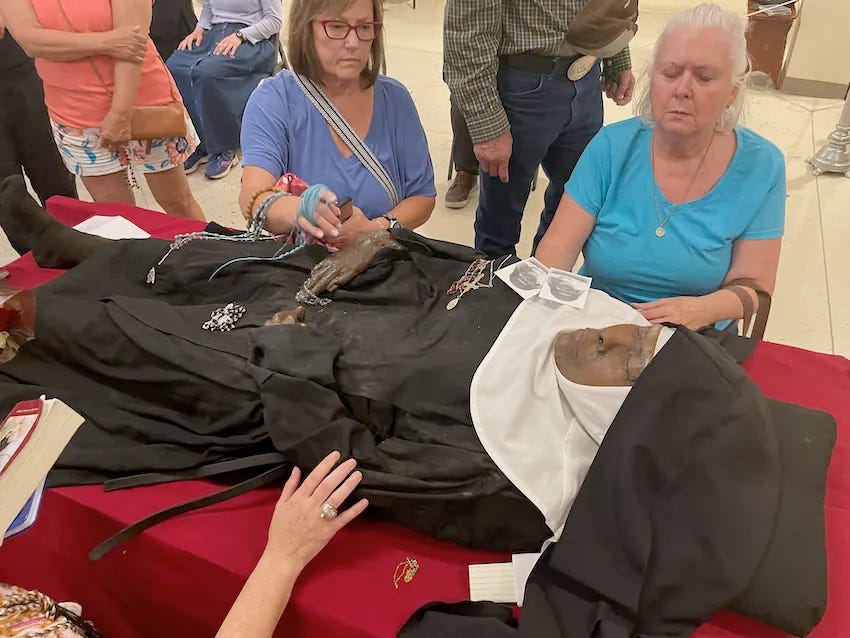Happy Friday friends,
I hope the week has treated you well.
Before we get into the news this week, I’d like to say a real and sincere thanks to those of you who sent me emails and messages after last week’s newsletter asking for feedback on “rightsizing” The Pillar.
I’d be lying if I said there was an overwhelming or obvious consensus from everyone on the “less-is-more” vs. “more-is-more” question, but you were all incredibly generous with your time, and I have to say many of the comments were very thought-out, and clearly the fruit of more than a minute’s reflection.
Seriously, guys, we appreciate it.
And I appreciate all of the messages of encouragement that came along with the feedback. It is absolutely clear that we at The Pillar have something truly special going here — and it isn’t down to us, it’s down to the group of genuinely great people around The Pillar who have helped it serve the Church.
And for those thousands more of you reading this newsletter and thinking “Hmm, I do like being able to read what they report every week…”, it would be a really fantastic time for you to think about coming all the way on board here and becoming a paying subscriber.
The News
It wouldn’t be a Friday these days without some new news in the strange case of the Carmelite Monastery of the Most Blessed Trinity vs. Bishop Michael Olson of Fort Worth.
This week, the nuns’ attorney announced that, in addition to the million-dollar civil suit they’ve already filed against the bishop and the diocese, the convent has made a complaint to the police about the seizure of phones and computers by the bishop’s team.
The diocese fired back, denouncing the move as “another transparent attempt to spread baseless and outrageous accusations regarding Bishop Olson’s legitimate investigation,” and releasing photos they claim show a lot of marijuana use at the monastery.
We’ve said since we first started reporting this story that nothing about it makes sense, and that it would be a mistake to leap to any conclusions before we know more.
At this point, I’d say the more we learn, the less of it makes sense. But there will, I am sure, be more to report as we go along.
Just this morning, a statement came through from the nuns’ lawyer calling the diocese’s claims about bongs in the cloister “absolutely ridiculous” and saying that the images of drugs in the convent “could have easily been staged and doctored by anyone.”
The lawyer said the diocese’s response to his own release about calling in the cops was “a juvenile, low-level public relations stunt by the diocese.”
So, that’s the level of the discourse this morning.
You can catch up with the latest here.
—
In news from a different convent in markedly happier circumstances, this week we spoke with Mother Abbess Cecilia Snell of Gower Abbey, Missouri, where the body of the order’s founder, Sister Wilhelmina Lancaster, was discovered to be apparently uncorrupt last month.
After weeks of pilgrims arriving at the abbey (including JD, albeit as a recorder of the event) Mother Cecilia talked with us about what comes next, and what God might be saying at Gower Abbey.
Here’s a preview:
To see her again brought us all a deep sense of hope, a sign that death is truly not the end of our story.
Her body points to the resurrection on the last day, but also to life after death, when the soul goes forth to meet Our Lord. She was ready to meet Him, so it stands to reason that that would be reflected in her body, even though it is a rare favor granted to those of us who remain on earth…
It seems there have already been physical healings, some quite significant, though we wait on medical confirmation of those.
But there have been many more spiritual ones: people coming back to the faith, finding strength and peace in their trials, and experiencing Sister Wilhelmina's prayerful support, even as she has left us for a better life.
She has shown us that our Redeemer lives, and is eager to help, using Sister as a conduit of his grace among all of us still on earth, we who are preparing to meet Him face to face on our journey home.
Read the whole conversation here.
—
A Catholic diocese in India is appealing against a court’s decision to deny bail to a bishop in an alleged “forced conversion” case.
The bishop, the diocese, and the religious order that runs the orphanage all deny the charges and say it is part of a wider campaign by government authorities to prosecute and shut down Christian apostolates in the country.
The appeal is due to be filed at the high court of the central state of Madhya Pradesh, which promulgated a law in 2021 criminalizing “unlawful” conversions and making clerics liable for years in prison if they help someone become a Christian without giving 60 days’ notice to the court, among other conditions.
—
Fr. James Jackson, a member of the Priestly Fraternity of St. Peter (FSSP), pleaded guilty on Thursday to a felony count of receiving child sex abuse material.
The priest, a prominent member of the FSSP, a clerical association that offers the Extraordinary Form of the Mass, is currently incarcerated in a federal detention center in Rhode Island with his priestly faculties suspended.
The priest is facing five to 20 years in prison and will be sentenced in September.
His case is noteworthy, in no small part, because of the outpouring of skepticism that followed his initial arrest in 2021, with many who knew Jackson from his ministry in Colorado and later Rhode Island suggesting the charges against him were either a mistake, or some kind of sinister plot against him.
You can read all about the case, and his change of plea, here.
—
Cardinal Matteo Zuppi was in Ukraine this week, acting as Pope Francis’ special envoy in the Vatican’s old/new secret/public efforts to help secure an end to the violence there.
Zuppi, president of the Italian bishops’ conference, will have had his work cut out for him in Kyiv, given the overwhelming skepticism with which Ukrainians now view the Holy See, and the pope personally.
But, as Luke Coppen writes in an analysis this week, Zuppi has considerable, serious, peace-making experience, and if anyone may actually be up to the job, it might be him. The real issue facing the cardinal, as Luke points out, is figuring out what, exactly, his mission is before he can seriously get to grips with making it happen.
This is a really perceptive look at the diplomatic chessboard onto which Francis has sent Zuppi, and I would seriously urge you to read it.
—
Also this week, Luke took a long look at the situation in the French Diocese of Fréjus-Toulon, which for years bucked the trend of declining vocations and served as a home for ecclesiastical movements and groups of nearly every kind.
Now, for the second year running, no ordinations will take place in the diocese, after the Vatican imposed a moratorium while it investigates the diocese’s admissions policy.
So, how does a bishop with a background in the charismatic movement become known for his welcoming embrace of liturgically traditional groups, and lots of others in between? And what exactly seems to have gone wrong in southern France?
You can read the whole analysis here.
—
The Institute for Works of Religion, or “the Vatican Bank” to scriptwriters and hacks, published its annual report this week.
It is, by anyone’s measure, an impressive performance by the bank.
As most of you know, I’ve been bullish on the IOR, and its leadership team, for a while now. In the post-Pell era, it has emerged as the most credible, and most effective agent of financial reform the Holy See has right now.
I’m glad to see its hard work is paying literal dividends, and the numbers in the report make it even clearer why Pope Francis reversed one of his own key financial directives to order all the Holy See’s liquidity and assets to be put under IOR control late last year.
Bringing all Vatican assets and interests onshore to Vatican City and under the IOR’s roof is going to be a massive undertaking and, I suspect, resisted by a lot of the institutions affected.
So next year’s report should make for even more interesting reading.
In the meantime, catch up with what progress in Vatican finances looks like right here.
Reaping what you sow
Going back to the situation in the Diocese of Fort Worth for a moment:
Pretty much every report we’ve published at this point has provoked some strong reactions from readers — for or against Bishop Olson and the nuns.
And while we continue to say it’s too soon to leap to any conclusions, I cannot blame anyone for having done so — in fact, I’d say the story is being perfectly pitched to capture people’s interest and provoke speculation, by both sides.
And there’s a debt accumulating from all this provocation.
On the side of the convent, the statements coming from the legal team are getting increasingly bombastic and, I think it’s fair to say, incendiary. And in a sense, I get that: you don’t file a million-dollar lawsuit and send out press releases unless you’re looking for coverage.
The nuns appear (or at times have appeared) to be the underdog in all of this, and whipping up popular pressure isn’t an unreasonable strategy, especially if you’ve little faith in how the canonical process against you is being handled.
An aggressive media strategy is, to be fair, also a solid way of ginning up sympathy and deflecting any reflexive scrutiny of your own story, if you can frame the narrative to paint yourself as the obvious victim of vindictive authority.
But the scrutiny is coming.
It’s not enough to wave away diocesan-published mages of near-industrial quantities of weed in the convent, and say they could be photoshopped. It’s increasingly clear to everyone watching that something is happening behind the convent walls, and just yelling “Bishop bad!” in press releases isn’t going to make questions go away.
As for Bishop Olson and the diocese — their recent release about the convent being better stocked than the concession stand at a Phish concert notwithstanding — they keep insisting that “this is an internal matter and should not be played out in the press.”
Yet they’ve continued to release just enough information at a steady enough pace to fan public interest, while always raising more questions than they answer.
As a strategy, it just doesn’t make any sense.
If there are longstanding issues at the convent, I’m not sure anyone’s interest is served by affecting a dignified silence about it at this point. And if Olson has followed a coherent and fair canonical process, as he has repeatedly asserted, it seems pretty reasonable to suggest he should be willing to answer questions about it — especially if his chancery is going to put out press statements accusing a nun of sexual sins one week, and publicizing her decree of dismissal from her order a few weeks later.
JD and I have both said, in print and to each other, that concerns about the canonical process to one side, there’s every reason to keep an open mind that Bishop Olson felt he had a real moral imperative to act, and act fast, here. And I remain convinced this is as likely to be proven true as any other outcome.
But justice in secret is no justice at all, and I don’t think it’s reasonable to think you can publicize an accusation and a summary punishment without being transparent about the process. And the simple fact of this story is: both narratives cannot be true. Sooner or later, that is going to be clear.
Rome, too, is rightly going to face some questions about how it has behaved in this case. There might be perfectly good reasons why the dicastery for religious orders was able to move with such uncharacteristic speed to back Olson’s actions so fully.
But if the Vatican isn't going to explain what makes this case, dismissing a wheelchair-bound nun walled off in a Texas cloister, so compelling, the faithful have every right to question the relative lethargy and indifference shown in response to priests like Fr. Marko Rupnik, S.J., who has been not just accused but convicted of some of the Church’s most serious crimes, without being dismissed from his religious institute.
Framed like that, I’m afraid there is simply no room for the Church’s hierarchy to ask for the benefit of the doubt here.
Regardless of whether the Diocese of Fort Worth or the Dicastery for Institutes of Consecrated Life like it, they have a fairly major public scandal on their hands in Arlington, one they have played no small part in fueling. They have an obligation to do their part in clearing it up.
If they don’t, the faithful will simply log the case of the Texas nuns as yet another instance in which reasonable questions aren’t answered, reasonable concerns are ignored, and reasonable doubts are planted about the rule of law in the Church.
Theseus’ watch
I actually read the NZZ reasonably frequently. It’s the go-to newspaper if you’re interested in Swiss banking scandals and judicial decisions about, say, rogatory requests from the Holy See prosecutor’s office.
But this story is about a watch. I know, I know, but bear with me here, this is really interesting, I promise.
The watch in question is, or was meant to be, a 1957 Omega Speedmaster, an early model of the watch that would eventually go to the moon on Apollo XI.
This particular watch was sold at auction in 2021 and was expected to fetch between $80,000 to $130,000. A lot of people would consider that to be a lot of money for an old watch, I grant you. But when the hammer came down, the Speedmaster went for more than $3,000,000 — THREE MILLION BUCKS.
It was easily the most ever paid for an Omega.
Apparently, it had gone to an anonymous collector in China, which wasn’t a huge surprise. Whales from Macau have been making a big splash in the watch world recently.
For watch nerds like me, the sale was a big deal at the time, and a lot of people argued about whether this was the post-COVID luxury watch bubble (there really was such a thing) gone crazy, or whether this was a fair price for a rare find.
I won’t bore you with the details, but the reason for the price was that the watch was believed to be totally intact, a true original, all original parts, in great shape, and — crucially — it had a flawless “tropical” dial.
In watch-geek-speak, this means that the originally black watch face had bleached in the sun over the years to a deep khaki color, and this one had aged perfectly evenly.
This kind of perfect aging is very rare, and for antique watch nuts, which are a whole subculture in the watch world, it’s what you really, really want. That in this case, it was on an intact early model of a very famous watch made it a kind of horological unicorn.
The general consensus was that this was a ridiculous price for a one-off watch, and everyone just enjoyed the moment.
But then things got interesting. Like I said, aged dials like this are rare — rare enough that everyone with an interest remembered seeing a similar one on another watch, offered for sale not long before.
That earlier watch failed to meet its reserve price of $50,000 because there was a lot about it that wasn’t original — the seconds hand was wrong, and it didn’t set off a Geiger counter, meaning that the luminescent material on the hour markers and hands was modern tritium, not the telltale radioactive radium of a midcentury watch.
The movement inside the watch was clearly from a later model, too, and the serial numbers of some of the parts didn’t match the case. It was what collectors call a “Frankenwatch.”
But collectors couldn’t shake the feeling that the two dials were too rare and too similar. So the watch team at the NZZ got to work.
(Protip: if your newspaper doesn’t have an investigative watch desk, you need a better newspaper.)
Here’s what they pieced together: The first watch had been quietly sold for less than the asking price, and then someone had painstakingly sourced parts for it, to reconstruct it back into an “original” that could be sold for a much higher value. The seller even had microscopic parts hand-made to spec when they couldn’t be found, and engraved and aged with period-specific serial numbers.
This in itself raises some interesting questions about what makes a watch, or any item, an “original.” It’s a sort of horological version of the “Ship of Theseus” paradox. If Theseus’ ship is preserved for centuries, but over the centuries every part is gradually replaced, like for like, to keep it intact, is it still “his ship”?
There’s a lot of disagreement among collectors about this. Some would argue it’s an “original” only if every single part, damaged and worn, remains in place. Others think that as long as all the replacement parts are themselves “original” to the model and year, it’s fine. And some would say that replacing the irreplaceable bits with what you can get to make it work is just part of keeping a watch “alive” throughout the decades.
Wherever you fall on the spectrum, everyone agrees all this affects the price, though.
So the hunt was on for the three million-dollar man who’d broken every record buying an Omega that now looked to be anything but the genuine original it had been sold as. But no one could.
The guys at NZZ figured something else out, too. Some of the made-to-order parts that had been used to gussie up the tropical Speedmaster for sale were too perfect. They could only have been created by someone with access to Omega’s internal historical archives.
So the reporters started snooping around and found the inside men at Omega: employees who’d helped make the tropical Frankenstein by passing over technical details of long discontinued parts.
But then things got really weird. Nowhere in all this was the buyer, who would, you’d think, be screaming for his three mil back.
Well, it turns out the Chinese whale rumor was just that. The anonymous bidder for the watch was actually Omega itself — they’d paid a record-beating price for a fake Ship-of-Theseus version of one of their own watches.
Why would they do that, you ask?
Watch companies like Omega and Rolex will often quietly buy back rare examples of their own work for display in their own museums. And if they happen to do it for a headline-catching price… well, that’s just good PR.
But here’s the punchline: it turns out the guys at Omega who convinced the company to buy the $3m “fake” were the same ones who helped create it in the first place.
They used their insider knowledge and access to create a perfect product they knew they could convince their bosses to buy for any price — and it worked. Amazing.
They would have got away with it, too, except for those meddling kids at NZZ. This is just great investigative journalism. And a fascinating read.
And the lesson here is, whether you’re working in a luxury watch company or for a Vatican financial department: don’t mess with journalist watch nerds. We live for this stuff.
See you next week,
Ed. Condon
Editor
The Pillar









